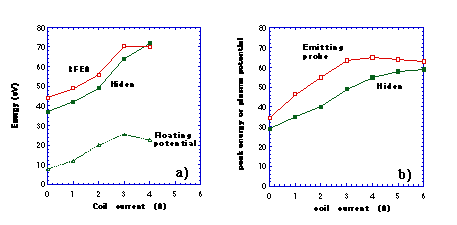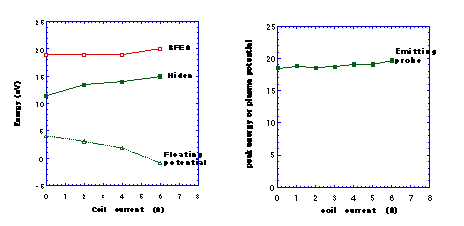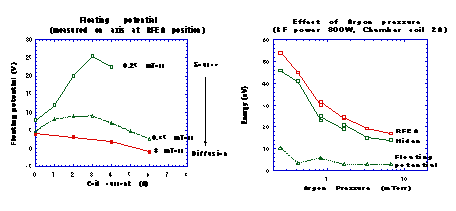Comparison Between RFEA and ESMS of Plasma Ion Energies
B W Roswell, C A Davis A J Perry, G D Conway, S Pautonier, C Charles, and
A Durandet
Space Plasma Group, Plasma Research Laboratory, RSPhysSE,
The Australian National University, Canberra ACT 0200, Australia
In a helicon diffusion plasma, we have measured the ion energies using an Energy Selective
Mass Spectrometer. These results are compared to measurments taken using a Retarding
Field Energy Analyser, and to the plasma potential measured using an emissive probe.
The aim of this work is to build our confidence on the use of these techniques
1. Introduction
Three techniques are used to measure the ion energies in a helicon diffusion plasma:
- Retarding Field Energy Analyser (RFEA)
- Energy Selective Mass Spectrometer (Hiden Analytical Ltd, plasma monitor HAL EQP),
- Emitting Langmuir probe.
The floating potential is measured using a Langmuir probe.
These techniques are compared using results obtained on a HARE plasma processing system
[1], by investigating the effect of the confining magnetic field on at two different
Ar pressures, 0.25 mTorr and 3mTorr. The ESMS is located at the wafer position, further
away from the plasma source than the RFEA and the probes, which are located in
the middle of the diffusion chamber.
2. The RFEA
The RFEA has been developped in house. Its main characteristics are:
- Electric potential on grid eliminates ions with lower energy than the discriminator
voltage
- Additional grids used to eliminate electrons and to suppress secondary electrons (4
grid system)
- Data obtained under computer control for immediate analysis using LabVIEW software
- Earthed probe around 1 cm2 area
- Can be moved to obtain spatial resolution (Eg radial profiles)
- Ion energy distributions can be obtained with high time resolution (<1ms)
- Energy resolution of 0.3 eV has been obtained
3. Experimental Results
At low pressure, as shown in Fig.1, the plasma potential increases with coil current;
very high plasma potentials are measured, up to 70V. ESMS results are always lower
than RFEA, and the difference decreases with magnetic field. The emitting probe is
consistent with RFEA.
At higher pressure (Fig.2) there is a much smaller increase in plasma potential with
coil current. ESMS results are always lower than RFEA, and the difference decreases
with magnetic field. The Emitting probe is consistent with RFEA.

Fig.1: Effect of the confining magnetic field on the ion energy at 0.25mTorr
a) comparison between RFEA and ESMS
b) comparison between ESMS and emissive probe

Fig.2: Effect of the confining magnetic field on the ion energy at 3mTorr
a) comparison between RFEA and ESMS
b) emissive probe
Fig.3 shows the evolution of the floating potential with the confining magnetic field,
for different argon pressures. At low pressure the floating potential increases with
coil current: this is indicative of changes in the plasma potential in the Helicon
source. This is consistent with mean free path bigger than the source-probe distance.
At higher pressures the floating potential decreases with coil current: this is indicative
of the plasma potential being controlled by the diffusion of plasma from the source.
This is consistent with mean free path shorter than the source-probe distance.

Fig.3: Evolution of the floating potential with the confining magnetic field for
different argon pressures
Fig.4: Effect of the argon pressure on the ion energy and on the floating potential.
As shown in Fig.4, there is a strong decrease in plasma potential with argon pressure.
ESMS results are always lower than RFEA, and the difference decreases with pressure.
Conclusions
The RFEA results are consistent with emitting probe results; ESMS measurements always
give lower energy. The difference between ESMS and RFEA measurements is consistent with the decrease in plasma
potential due to decrease in density along the axis (Boltzmann relation). All three
techniques give consistent results over a range of plasma conditions. These results increase our confidence in the use of the ESMS technique as well as in the results
given by our RFEA.
 Return to SP3 Home Page
Return to SP3 Home Page



